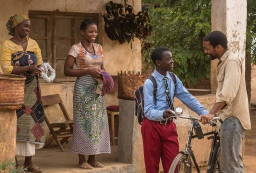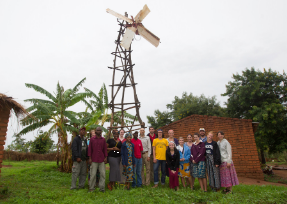|

A Malawian anecdote, still inspiring
|
A Malawian teenager transformed his village by building electric windmills out of junk is the subject of a new book, ‘The Boy Who Harnessed the Wind’.
William Kamkwamba, Self-taught, has been feted by climate change campaigners .
His against-all-odds achievements are all the more remarkable considering he was forced to quit school aged 14 because his family could no longer afford the fees.
When he returned to his parents' in the central Malawian village of Masitala, his future seemed blink.
The teenager had a dream of bringing electricity and running water to his village.
And he was not prepared to wait for politicians or aid groups to do it..
The need for action was even greater in 2002 following one of Malawi's worst droughts, which killed thousands of people and left his family on the brink of starvation.
Unable to attend school, he kept up his education
|
|
by using a local library, where he read science books.
His life changed one day when he picked up a tattered textbook and saw a picture of a windmill.
Mr Kamkwamba told the BBC News website: "I was very interested when I saw the windmill could make electricity and pump water”.
"I thought: 'That could be a defence against hunger. Maybe I should build one for myself”
William Kamkwamba, from Malawi, is a born inventor. When he was 14, he built an electricity-producing windmill from spare parts and scrap, working powers from rough plans he found in a library book called Using Energy and modifying them to fit his needs. The windmill he built four lights and radios in his family.
With nothing more than a fistful of cornmeal in his stomach, a small pile of once-forgotten science textbooks, and an armory of curiosity and determination, he embarked on a daring plan to bring his family a set of luxuries that only two percent of Malawians could afford and what the West considers a necessity–electricity and
|
|
|
running water. Using scrap metal, tractor parts, and bicycle halves, William forged a crude yet operable windmill, an unlikely contraption and small miracle that eventually powered four lights, complete with homemade switches a circuit breaker made from nails and wire. A second machine turned a water pump that could battle the drought and famine that loomed with every season.
The windmill stands on a tripod of wooden polls about five metres above the ground. It consists of locally-available materials and as far as he can remember his investments were K500 for two bearings, K500 for a bicycle dynamo, K400 for a fun belt and K800 for a bicycle frame.
The propellers are made of plastic pipes supported by sticks so that they should not bend when the wind is strong and placed almost vertical to the direction of where the wind comes from.
Unlike most windmills, where the propellers turn the spindle connected to the turbines directly, William added pulleys to his machine to increase speed thereby generating more energy.
There are three pulleys and the last is connected to a bicycle wheel. When this wheel turns, it spins a dynamo which in turn generates electricity.
After reading about Kamkwamba, TEDGlobal Conference Director Emeka Okafor spent several weeks tracking him down at his home in Masitala Village, Wimbe, and invited him to attend TEDGlobal on a fellowship. On stage, Kamkwamba talked about his invention and shared his dreams: to build a larger windmill to help with irrigation for his entire village, and to go back to school.
Following Kamkwamba's moving talk, there was an outpouring of support for him and his promising work. Members of the TED community got together to help him improve his power system (by incorporating solar energy), and further his education through school and mentorships. Subsequent projects have included clean water, malaria prevention, solar power and lighting for the six homes in his family compound; a deep-water well with a solar-powered pump for clean water; and a drip irrigation system.
|
|
Kamkwamba himself returned to school, and is now attending the African Leadership Academy, a new pan-African prep school outside Johannesburg, South Africa.
Kamkwamba's story is documented in his autobiography, The Boy Who Harnessed the Wind: Creating Currents of Electricity and Hope. A documentary about Kamkwamba, called William and the Windmill, won the Documentary Feature Grand Jury award.
He then went on to build a second, larger windmill to power irrigation pumps. He did this all from books he read in the library.
William Kamkwamba dreamed of studying science as a child but was forced to drop out of school when famine struck Malawi in 2002, reducing his family to foraging for food to survive. “Yet William refused to let go of his dreams,” says his autobiography(written with Bryan Mealer), The Boy Who Harnessed the Wind, published in 2009: He remembered, ‘many, including my mother, thought I was going crazy.’
News of Kamkwamba’s accomplishments spread rapidly, which garnered him international renown. He was invited as a guest to a TED conference in Tanzania in 2007, then received a scholarship to study at the African Leadership Academy in Johannesburg, South Africa, and with the help of an American sponsor attended Dartmouth College in New Hampshire, from which he graduated in 2014. He remains involved in many engineering and construction projects and charities in his home village of Dowa, Malawi.

|
|
|
